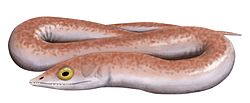| Adelospondylus Temporal range: Carboniferous, | |
|---|---|
 | |
| Life restoration | |
| Scientific classification | |
| Kingdom: | Animalia |
| Phylum: | Chordata |
| Order: | † Adelospondyli |
| Family: | † Adelogyrinidae |
| Genus: | † Adelospondylus Carroll, 1967 |
| Type species | |
| Adelospondylus watsoni Carroll, 1967 | |
Adelospondylus is an extinct adelospondyl tetrapodomorph from the Carboniferous of what is now Scotland. [1] [2]





